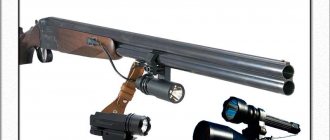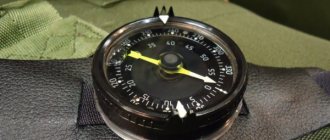Features of caring for a hunting rifle
The hunting process does not take place in laboratory conditions. In forests and swamps, on the banks of rivers, lakes and seas, weapon metal comes into contact with moisture, dust and sand. Water, especially sea water, is dangerous because it causes rusting of all metal parts. At first these are small dots, which quickly turn into chips, and then into shells. Well, dust and sand work as a full-fledged abrasive, causing scratching and mechanical abrasion of weapon parts.
The use of black powder is especially dangerous - it produces an order of magnitude more soot than smokeless gunpowder, and this soot has pronounced hygroscopic properties (pulls moisture out of the air). Another dangerous point characteristic of smooth-bore weapons is the possibility of breakthrough of combustion products of the primer when the paper sleeve ruptures. They not only have a strong rusting effect, but also form carbon deposits in the barrel and on the block, and also penetrate into the locks.
In addition, when using unsheathed lead bullets or shot, the barrel may become leaded; when using jacketed bullets, there is a possibility of copper plating (although this problem is more typical for rifled weapons). The worse the condition of the surface, the higher the rate of lead formation; the presence of numerous shells is especially unfavorable in this regard.
In this regard, it is recommended to carry out at least two cleanings:
- draft - at every long rest and immediately after the end of the hunt;
- finishing - immediately upon returning home.
During hunting, extraordinary cleaning may also be required: if the gun falls or you drop it, you need to unload it and make sure that no earth, sand, dirt or snow gets inside the barrel, because when fired, a partially clogged barrel can swell or even rupture.
In addition, during the off-season, when hunting is not carried out, it is recommended to carry out preventive cleaning and lubrication of weapons at least once a month.
When to clean
There is a fairly common misconception that says that frequent cleaning is harmful to the gun, as it leads to scratches, abrasion of chrome surfaces, and so on. It should be noted that if you neglect basic tips on how to properly clean a gun, then an expensive weapon can break down much faster - within a couple of years.
Experts recommend cleaning your weapon at least once a month, even if it has not been used.
In addition, there are strong recommendations, including from manufacturers, when cleaning is simply necessary:
- after purchasing a new gun;
- in the process of shooting it;
- after every hunt;
- at the end of the season.
Cleaning the weapon immediately after purchase allows you to get rid of smudges of factory lubricant. In addition, this is another reason to carefully inspect the weapon in a calm environment, check the operation of the trigger mechanism on a spent cartridge case, and make sure the quality of the weapon’s assembly.
When zeroing on a stand or in a nearby ravine, the gun is cleaned literally after every shot. When using cartridges with smokeless powder, it is recommended to carry out hygienic procedures at every long rest, and when shooting with black powder - immediately after a hunt.
During the off season, the gun is, of course, not used. But this does not mean that it is guaranteed to be free from moisture and corrosion. It is advisable to carry out cleaning and lubrication monthly.
Materials and tools for cleaning guns
There is a minimum set of tools and accessories that every hunter should have. It includes:
- cleaning rod - aluminum or wooden, consisting of two or three segments;
- metal brush - designed to remove rust, carbon deposits and metal residues when cleaning lead or copper plating;
- bristle brush - used for applying alkaline lubricant;
- soft brush - use it to apply neutral lubricant;
- vishers - special devices screwed onto a ramrod; hold rags and pieces of rag;
- a set of brushes - to remove debris, dirt and dust;
- wooden sticks (“toothpicks”) - to remove dirt from crevices and other hard-to-reach places;
- lubricants and oils.
Having all this, you can clean the gun both at a rest stop and at home, in a calm environment. The above list is basic - an experienced hunter can (and even should) expand it.
How to properly clean and lubricate a 12 gauge shotgun
In order to avoid omissions, let’s say right away that there are a lot of legends, myths and opinions in this area of knowledge. The most radical of them: cleaning weapons is harmful. As a rule, it is followed by those who have ruined the barrel or bolt group through incorrect actions, for example, the wrong choice of lubricant. Or - you will laugh - owners of models with extremely difficult disassembly/assembly and access to the breech.
The author belongs to the group of “moderates” who believe that excessive enthusiasm for cleaning and lubrication, especially without a critical understanding of the essence of the processes, also does not lead to good. This is mainly due to long-standing experience, when shooters had kerosene (then WD-40 spray), an alkaline compound and neutral oil at their disposal. Weapons maintained with the help of these components have served faithfully and continue to serve for many decades, failing for reasons not related to the chemistry used and the frequency of hygiene procedures. I note, however, that all this applies to serial domestic shotguns, albeit high-quality ones, as well as to civilian versions of army rifles - OP-SKS, "Tiger", numerous "Kalashoids".
With the advent of specialized chemicals, especially aerosol ones, on our shelves, everything has become even simpler. For example, the same legendary “Ballistol” allows you, after a day full of shooting and rain, to simply wipe all the iron, fill it inside and out with this spray and not worry about anything else until you get home, where you can clean it in a more comfortable environment.
And finally, “maximalists”, most often fans of high-precision shooting. People of this type practice thoroughness in everything. As a rule, they prefer a table covered with newspapers, albeit a compact one, but still a center for cleaning. For example, like the one in the photo, the extremely inexpensive Portable Maintenance Center.
Rough cleaning of the gun
Rough cleaning is carried out to remove the most aggressive contaminants. It is carried out immediately as soon as the hunt ends, regardless of whether shooting took place or not.
After unloading the weapon, you need to remove the barrel from the block (or break the barrels) and wipe all parts with a dry rag, removing dirt, dust and moisture. For narrow and hard-to-reach places, use pointed wooden sticks and a toothbrush.
Then, using a cleaning rod, a small cloth and alkaline lubricant, clean the barrels until the cloth stops getting dirty. After this, the barrels and all external metal parts (including the locking mechanism) are coated with neutral lubricant (in the absence of weapons-grade lubricant, you can use spindle or transformer oil). Having done this, the gun needs to be sheathed.
Keep in mind that if you immediately bring a weapon into a warm room in the cold season, it will fog up, and this is unacceptable. Therefore, it must be wrapped in a blanket and clothes, brought inside in this form and waited for several hours until the metal heats up.
Rules for cleaning weapons
Cleaning weapons, let's look at the nuances.
Do you remember that Leskov’s Lefty asked him to tell the Tsar Father that the soldiers should not clean their guns with crushed bricks? Look, when did people in Rus' think about the abrasive properties of ceramics and the correct technologies for cleaning weapons! Seriously, not so long ago, in remote places, trunks were simply “soaked” with boiling water, then chased away with a brush and wiped dry. But do not rush to accuse your ancestors of barbarism. The same operation is carried out for modern pneumatics for collective use in very advanced cases, when the barrel is so leaded that no chemicals or mechanical devices can handle it. Physics comes to the rescue: due to the difference in thermal expansion coefficients, lead flakes safely peel off from the steel. I think that among the readers there are no enthusiasts of a bubbling kettle or, God forbid, an electric drill as a drive for a brush.
How to properly clean a weapon
In order to avoid omissions, let’s say right away that there are a lot of legends, myths and opinions in this area of knowledge. The most radical of them: cleaning weapons is harmful. As a rule, it is followed by those who have ruined the barrel or bolt group through incorrect actions, for example, the wrong choice of lubricant. Or - you will laugh - owners of models with extremely difficult disassembly/assembly and access to the breech. The author belongs to the group of “moderates” who believe that excessive enthusiasm for cleaning and lubrication, especially without a critical understanding of the essence of the processes, also does not lead to good. This is mainly due to long-standing experience, when shooters had kerosene (later WD-40 ), an alkaline compound and neutral oil at their disposal. Weapons maintained with the help of these components have served faithfully and continue to serve for many decades, failing for reasons not related to the chemistry used and the frequency of hygiene procedures. I note, however, that all this applies to serial domestic shotguns, albeit high-quality ones, as well as to civilian versions of army rifles - OP-SKS , " Tiger ", numerous " Kalashoids ". With the advent of specialized chemicals, especially aerosol ones, on our shelves, everything has become even simpler. For example, the same legendary “ Ballistol ” allows you, after a day full of shooting and rain, to simply wipe all the iron, fill it inside and out with this spray and not worry about anything else until you get home, where you can clean it in a more comfortable environment. And finally, “maximalists”, most often fans of high-precision shooting. People of this type practice thoroughness in everything. As a rule, they prefer a table covered with newspapers, albeit a compact one, but still a center for cleaning. For example, such as in the photo, extremely inexpensive Portable Maintenance Center .
And it’s hard to disagree with them.
Look how thoughtfully and conveniently everything is done. When you read the recommendations of adherents of “high precision”, you are amazed at the perseverance and scrupulousness, the purely scientific approach to removing various types of contaminants. Can you imagine what kind of practical experience and surgical precision of movements you need to have in order to remove copper plating on match barrels using abrasive pastes!? Their arsenal of techniques includes, for example, the selection of chemicals for cleaning different areas of the chamber, methods that provide for special cleaning after each shot, and the use of substances that are neutral to some barrels, but literally dissolve the metal of others. Benchrest shooter , you shouldn’t engage in guerrilla warfare—come out of the forest to people and join a team of like-minded professionals. Moreover, there is no “Benchrest ” without regular competitions. For the majority of people, all this is somewhere on the other side of good and evil. Therefore, let us be guided by the condition “necessary and sufficient” known from mathematics. Without stopping at the basics of preliminary procedures, such as the need to unload and disassemble the weapon, prepare all the necessary accessories, etc.
Basic steps when cleaning weapons
- filling with an alkaline composition (solvent) everything and anything that came into contact or could come into contact during the firing process with the primer, cartridge case, bullet and, of course, powder gases;
- actual cleaning;
- weapon lubrication.
For the vast majority of cases and non-exclusive weapons, the already mentioned “Ballistol” or the well-known “ Hoppes No. 9 ".
The first one is extremely convenient to use, since it is made in the form of an aerosol, it quite successfully copes with all contaminants, including lead and copper plating, while being absolutely safe. And not only for the wood or plastic of the stock, but also for your hands. Moreover, according to the manufacturer and numerous users, it has a bactericidal and generally beneficial effect on the skin. "Hoppes", on the contrary, is very toxic, so the author does not really like its relatively rare aerosol version. You can grab a dose even in the fresh air. It copes with its direct responsibilities perfectly, perhaps better than Ballistol. Shooter's Choice formulations , but many of them are highly specialized. For example, they can only be used for stainless steel barrels. If you are the owner of such a weapon, which is not too widespread, carefully study the manufacturer’s recommendations. So, the composition we have chosen is applied to all areas to be cleaned - the barrel bore, the bolt, the mirror (at the smoothbore), the gas outlet parts, the outside of the barrel - 5-6 centimeters from the cut. We leave the entire household to soak for 10-20 minutes.
Cleaning weapons
Here we will need tools that are closely related to the characteristics of the weapon. Let's look at everything in detail.
1. Cleaning rod
Somehow it has long been the custom that for rifled weapons it must be one-piece, for smooth-bore weapons it makes no difference, but more often it must be composite. The approach is correct, taking into account the caliber: you never know what can happen in a long tube, the internal diameter of which is less than a centimeter, so the requirements for strength characteristics in the first case are increased. The cleaning rod material is also different. For a smooth bore, wood and brass are quite suitable; for a rifled bore, only metal, always braided, although bending-resistant and relatively safe stainless steel products are available on sale. Do not use aluminum devices under any circumstances; the oxide covering them has abrasive properties comparable to crushed brick. Another prerequisite for rifled barrels: the ramrod itself must rotate freely on a bearing installed in the handle, so that the cleaning devices, when moving back and forth, follow strictly the rifling.
Actually, ideally these options look something like this:
On the left is a cleaning rod for smooth-bore calibers, two-section, length 86 cm, the set includes a classic SL visher attachment . On the right is a cleaning rod for rifled weapons .35 cal., 9 mm and above, single-section, with bearing, length 91 cm.
2.Visher and patches
The chamber and bevel are sacred cows and should be treated as such. Therefore, the movement of the cleaning rod with the wiping material (patch) always goes in one direction - from the breech to the barrel. The insertion itself must be extremely careful, and the contaminated patch must be removed from the visher upon exiting the barrel. It’s very convenient to do this with vishers of modern design.”>
Compare: on the left is the classic type, familiar to almost all shooters, on the right is the brass .22/.223 cal.
Agree, it is very convenient to pin a branded or homemade patch on the latter (a square or round piece of cotton fabric, selected for the caliber), which, upon exiting the barrel, will simply fall off and fall into a carefully placed container.
It is clear that the reverse movement must be no less careful, so as not to damage the rifling ribs at the barrel cut, even with soft brass. This will lead to loss of accuracy of any rifled weapon, including pneumatic ones. Cutting defects will also not add accuracy to a smoothbore gun. And here, willy-nilly, you will have to use a traditional visher, into the slot of which a cloth of suitable size is threaded and loosely wound.
3.Cleaning guides
Somewhat ambiguous devices that serve to protect the chamber, the bullet entrance and the cut of the barrel of a rifled weapon.
The photo shows .30 ABS3 and .30 C30 guides. Let's start with the second one, for cutting the trunk. The scope of its application is extremely narrow, mainly for some models, and all because, as we remember, the barrel is cleaned only from the treasury to the barrel. There are rifles where the manufacturer, as if on purpose, did everything to make access to the breech difficult. But even here it is better not to resort to technology turned 180 degrees.
The guides inserted instead of the bolt, according to authoritative shooters, with rare exceptions do not provide accurate centering of the cleaning rod, since they are made universal for a certain caliber. Meanwhile, each rifle has its own characteristic features. In a word, it’s easier to protect the USM from dripping reagents with a cloth, and center the cleaning rod by eye; the main thing is not to rush or get nervous. Or thoughtfully, again without rushing, choose a guide strictly for your weapon.
4.Brush
There are also a lot of nuances here. In principle, you should remember two things: do not use soft polymer brushes (not to be confused with “puffs”), which generously scatter torn bristles everywhere, and steel brushes for rifled barrels. Hard nylon and copper or brass only. For smooth-stemmed steel, when removing lead and hard carbon deposits, the use of steel mesh devices is quite acceptable.
In the photo: brass and hard nylon brushes for .30 and 12 gauge, as well as a powder puff, which serves both for lubrication and for removing excess oil. There are also brushes for cleaning the chamber. As a rule, they come as part of cleaning kits, but they can also be purchased separately, even on a handle.
And one more important rule: brushes are used only when dry, otherwise they will immediately become covered with abrasive particles and only aggravate the process of destruction of the barrel mirror.
5. Lifesaver
You definitely won't be able to do without this device. Essentially, this is a kind of miniature hybrid of a spatula and a toothpick, carved from wood. It is with them, sometimes with a wrapped rag, that you will clean dirt from hidden places, of which there are plenty in the weapon, or carefully remove the remaining copper from the mirror of the end of the receiver (where the firing pins are).
The final stage of weapon cleaning
Depending on the configuration, we scrub various parts with a stick, sponge, or rag. After the dirt has disappeared, wipe it dry, generously lubricate it with neutral oil, wipe it again and now lubricate it with what is called a thin layer. We drip a little bit into the holes of the smoothbore strikers. It is clear that competition forces manufacturers to move and produce a wide range of solvents and oils. If you want to support them and do everything according to Feng Shui, you can purchase and use lubricants, say, separately for the stem or bolt stops or something else in the same spirit. But, in general, even domestic neutral gun oils, like Berkut , are quite functional. Blessed are the owners of classic break-in shotguns and other kiplaufs, as well as modern semi-automatic rifles. It’s more difficult for the rest - you can’t unfasten the barrel, and here the already mentioned branded cleaning center could be a great help. The basic rule: in a machine or just on a table, the barrel should point down so that all the nasty stuff does not flow into the weapon’s mechanisms. So, we put a patch on the visher (twist a rag) and in one leisurely movement we push the cleaning rod forward. We discard the contaminated patch and carefully remove the cleaning rod. We alternate patches with brushes (only on dry trunks). We clean the chamber with rotational movements, under no circumstances trying to push a special brush into the bullet entrance. If necessary, treat the barrel with the cleaning compound again. And so on until we achieve results. Professionals carefully evaluate contaminants, using specialized chemistry depending on their types.
For the average shooter, all this is more interesting in theoretical terms. Or when changing ammunition. So that you can say: “This is dirty!” And don't contact him anymore. Our task is simple: regardless of whether the copper on the patches turns blue or matte remains of polyethylene in the sleeve are found, we must ensure that the cleaning material at the exit does not differ from what was at the entrance. That's all. Depending on the degree of contamination, all procedures can take ten minutes or an hour. Finally, the patches emerge from the trunk pristinely clean. And it’s the turn of neutral oil. By and large, we use it to remove not so much dirt as the remnants of cleaning substances, including from metal micropores. Suspicious marks will again appear on the patches. After they disappear, apply a thin layer of neutral oil to the now dry trunk with a lightly lubricated patch, cloth, or powder puff. Or a preservative composition - depending on your goals and objectives. For example, Rust Prevent Corrosion Inhibitor or Elite Hoppe's GO4 .
It is highly advisable to repeat the second stage of cleaning (with neutral oil) after three to four days, maximum a week. This is how long, on average, the sweating of contaminant residues from the deepest microcracks continues.
I would like to repeat it again. With the variety of modern weapons, carefully read the manufacturer’s recommendations if you have, say, a stainless or chrome-molybdenum barrel. And select cleaning compounds, especially aggressive ones, strictly in accordance with them. Do not always trust opinions from the Internet; if you read carefully, they often contradict each other. In a word, be careful and careful.
Best wishes for a great hunt
Saltsov Igor
Thorough cleaning of the gun
Once you get home, start cleaning your gun more thoroughly as soon as possible. Your task is to completely remove contaminants from all parts.
At the beginning of the procedure, make sure that the gun is not loaded. Even if you remember exactly that you discharged it while hunting. The price of a mistake is a human life, and perhaps not even yours, but one of your family members. Therefore, when starting cleaning, always start by unloading, and do not forget to pull the triggers (but do not click the triggers just like that, this risks breaking the firing pin - insert a spent cartridge case or a piece of wood).
After which the gun should be wiped of any remaining lubricant and the barrels should be removed or broken.
How to clean trunks
There are two methods for cleaning barrels:
- traditional;
- on new technologies.
The traditional method involves the use of rags (rags) wound onto visers and an alkaline lubricant. At the first stage, lead is removed using a metal brush. Then, instead of a brush, a visher is screwed onto the cleaning rod and, using a rag, the barrel is cleaned until traces of lead are completely removed, after which it is coated with a layer of neutral lubricant using a soft bristled brush. If lead is difficult to remove, you can use a cloth soaked in turpentine or kerosene.
The modern method, in principle, repeats all the steps of the traditional one, but before cleaning the barrel is filled with special foam for 20 minutes, which corrodes and softens the lead. In the absence of such foam, you can independently make a similarly effective solution of the following composition:
- ammonium sulfate - 28 grams;
- ammonium carbonate - 13 grams;
- ammonia water - 170 grams;
- distilled water - 100 grams.
With both the traditional and the updated methods, the trunks are wiped dry after cleaning.
Subsequent cleaning steps
After the barrels, we move on to the choke constrictions - they are also covered with soot and lead. Cleaning is done in the traditional way, using a stationery needle, toothbrush and detergent, or in a more modern way - using a special weapons-grade solvent that dissolves deposits on the threads. Before re-screwing chokes, chucks and flares, apply a high-temperature compound to the threads to protect the nozzle from combustion products.
Now you can take care of the cartridge mechanisms - powder deposits also settle on them, they also need cleaning. You can do this using a wooden toothpick and a napkin, or use a solvent again. As in the case of narrowings, it will eat away the carbon deposits, and the remains can be removed with a cloth.
Now you can wipe all the external parts again, removing any remaining lubricants. As a result, an ultra-thin, almost imperceptible film should remain on them.
If you are not going to use the gun in the near future, then do not forget to treat it with preservative lubricant. One of the most popular preservative options is nigrol. It does not drain from the surface and protects against corrosion quite well. The only point is that if there is a possibility that nigrol contains an admixture of water, then it must first be dehydrated. To do this, use calcined table salt - just tie it in gauze and put it in a jar of nigrol for a day.
Let's start with the trunk
The key element of any gun is the barrel. Before the cleaning process itself, we prepare the working surface, which must be flat. Use a soft surface that will prevent the weapon from being scratched. Newspapers are also suitable because they absorb oil and combustion products from cartridges just as well. Provide a resting point for the muzzle before using the cleaning rod.
The disassembly process is as follows: we separate the receiver block from the box. If the gun is fractured, then the fore-end is first removed, after which the block is carefully removed. We support the butt with our free hand. Everything needs to be done above the table.
Semi-automatic machines are equipped with a cap screwed onto the magazine. It is the key fixator of the entire structure. Carefully unscrew it, move the bolt back 2-3 centimeters, remove the forend and pull the receiver unit with the butt in different directions (necessarily above the table). Beginners are advised to take photographs of the parts inside the forend so as not to become confused in their location in the future. The slightest mistake can lead to unstable operation of the gun.
We unscrew all the narrowings. Now you can begin to bring the weapon to its original condition in two ways:
- using old technologies;
- according to new ones.
Let's consider the advantages of each.
Cleaning the old fashioned way
So, we have prepared the barrel, now we will clean it using the “traditional” method. You will need special oil or lye, sold in gun stores. Apply it to the inner surface for about 20 minutes until the substance softens and prepares powder deposits.
Next, remove the lead with a steel brush until a characteristic mirror shine appears inside. After rough processing, take a napkin or a soft (preferably fiber) cloth and remove the remaining lead. Wipe the barrel dry.
Modern trends
Progressive cleaning is not much different, but the method is more convenient. The barrel is filled with foam (from the same store) and kept for up to 20 minutes. The composition is caustic; work only with rubber household gloves. Foam easily dissolves lead, copper plating and combustion products “sticking” to the inside of the barrel.
Next, a cleaning patch is screwed onto the cleaning rod. Unlike a rag, it fits tightly to the walls of the barrel, ridding it of the smallest particles of dust and dirt. Finally, wipe off all oil residues with a cloth.
Handguard and butt
These two items are made of wood or plastic and require special handling.
Wooden parts are quite capricious - they do not like moisture and strong temperature changes, so wet parts must be dried immediately. But not at high temperatures or in direct sunlight. Once a year, these wooden parts must be treated with special impregnations and antiseptics.
Plastic is more practical in this regard - it does not rot and withstands impacts well. However, it reacts very poorly to abrasive materials, so you need to wash plastic parts with a soft sponge in warm water. You can use detergents, but solvent is not the best option, as it can dissolve some plastics.
As you can see, there is nothing difficult in cleaning. Therefore, do not be lazy, follow the technology, and if the cleaning is correct, your gun will last for several decades.










